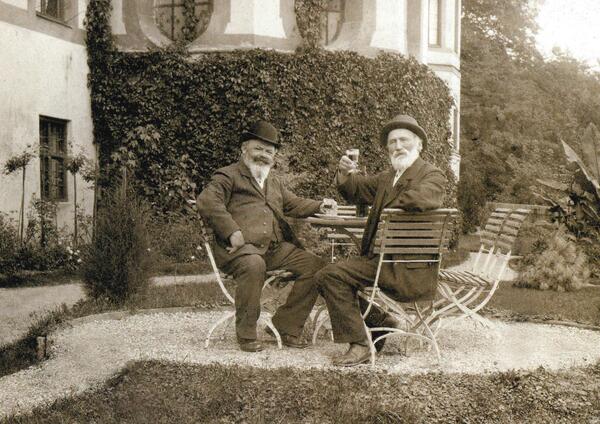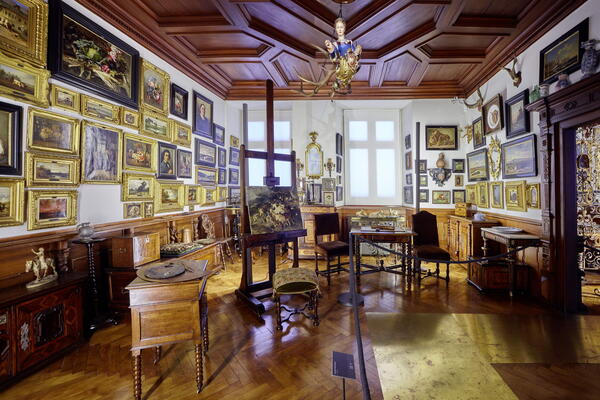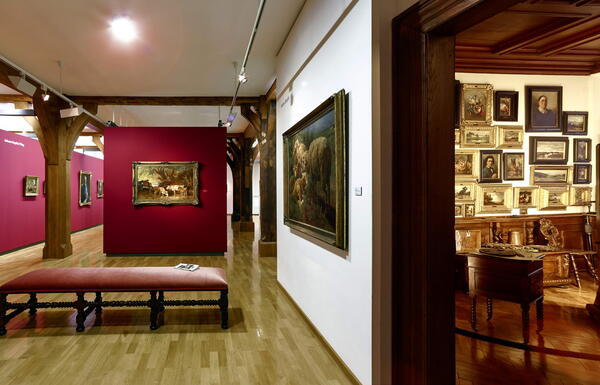The Braith-Mali Studios
The historical studios of the Munich animal painters Anton Braith (1836-1905) and Christian Mali (1832-1906) are the only completely intact 19th-century artist salons and thus exemplary cultural monuments. After both painters bequeathed their estates to the town of Biberach, their studio rooms were translocated from Munich to Biberach in 1906.
Anton Braith and Christian Mali
Anton Braith was born in Biberach in 1836. After apprenticing with the Biberach painter Johann Baptist Pflug and studying in Stuttgart, he settled in Munich in 1861. There he gained acclaim as an artist and had economic success. In the 1870s and 1880s, Anton Braith was regarded as one of the most distinguished animal painters in Germany.
Born at Broekhuizen Castle near Utrecht in 1832, Christian Mali grew up in Württemberg. After his parents died, he lived with his older sister and her husband, the artist Pieter Francis, who trained him as a painter. While Mali initially focused on scenic painting, especially of architecture, he moved on to become a well-known landscape and animal painter over the course of his life.
The Studios in Munich
In 1871 Braith and Mali took up communal residence in a house in Munich, in which they set up their studios. The commonly used term »Braith-Mali Studios« is somewhat misleading for modern readers, since the artists did not produce art in these rooms, but instead used them as representational salons. In the 19th century, art salons served as exhibition and sales rooms, over 300 existed in Munich alone. Here artists hosted get-togethers and festivities, received buyers, and presented a world of prosperity and good taste to their audiences. Like many artists of their time, Braith and Mali acquired their own collections for this purpose.
As collectors they were interested in different epochs and continents and not only purchased paintings but also furniture and other interior décor. They eclectically combined antique and contemporary, opulent and simple, and European and non-European pieces. The mixture represented the so-called salon style, a seemingly unsystematic, but in fact, intentional composition of items which illustrated the taste of the time. In the 1880s and 1890s, artful arrangements of this kind were the height of fashion. The message was clear: anyone with the means to acquire such treasures must be an artistic success.
The Translocation to Biberach
Throughout their lives, Braith and Mali maintained their connection with Biberach and the local Kunst- und Altertumsverein (Art and Antiquity Association). When Braith died in 1905, he left his artistic estate as well as 20,000 gold marks to his hometown for the establishment of a »Braith Museum«. Then in October 1906, shortly after the museum’s opening, Mali died. Like Braith, he bequeathed his estate to Biberach. The museum not only inherited his paintings, oil sketches, drawings, and the interior decoration of his studio, but also 60,000 gold marks, a fortune whose contemporary purchasing power is in the range millions. And thus, the »Braith-Mali Museum« was founded.
After their translocation to Biberach, the studios were reassembled as faithfully to their original form as possible and included not only the mobile inventory but also the wooden portals, the wooden paneling, and the ceilings. The only exception was the color of the walls. In 1906 it was already decided that museum-style white would serve as a better backdrop for the individual artworks than the original dark wallpaper. The heavy drapery and carpets did not survive either.
The fact that this ensemble is now in Biberach and no longer in Munich is a stroke of luck: Had the over 1,000 pieces not been moved to Anton Braith’s hometown, they would have probably been cleared out in the 1920s, as was the case with many Gründerzeit interiors. They would most certainly not have survived the Second World War. The house was hit by bombs in 1944 and torn down in 1951.
A Unique Cultural Monument
Today Biberach’s Braith-Mali Studios represent a first-rate rarity of art and cultural history. Regardless of a few incomplete ensembles in Bavaria, they not only boast the most opulent and complete furnishings but also serve as the only examples of the lost world of 19th-century parlors and salon painting. In 2005 they were added to the Denkmalbuch Baden-Württemberg (Baden-Württemberg Book of Monuments).



